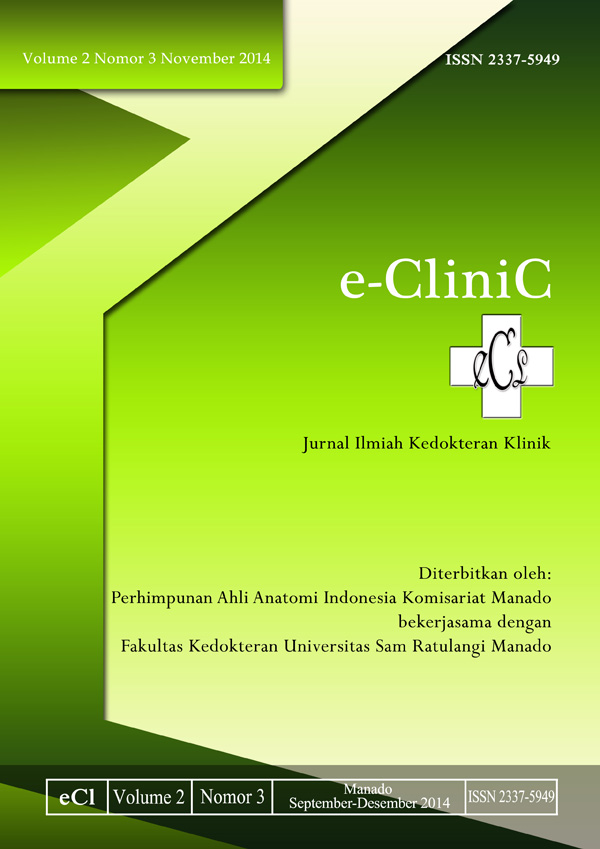HUBUNGAN PENGGUNAAN KONTRASEPSI DENGAN KEJADIAN KEHAMILAN EKTOPIK TERGANGGU DI BLU RSUP PROF. DR. R. D. KANDOU MANADO PERIODE 2009 – 2013
DOI:
https://doi.org/10.35790/ecl.v2i3.5758Abstract
Abstract: Ectopic pregnancy accounts for 1 in 200 (5-6%) maternal mortality in developed countries.2 According to the WHO, with over 60 000 annual cases in Indonesia– that is 3% of its population, the number of ectopic pregnancies in Indonesia is estimated to be on the brink to cases in developed countries.6 A risk factor for ectopic pregnancy that has surged over the years is the use of contraceptive methods. According to the research at the Department of Epidemiology and Social Medicine University of Brussels in the 90s and two consecutive research the at the Department of Obstetrics and Gynecology BLU RSUP Prof. dr. R. D. Kandou Manado in 2001 and 2011, the use of contraceptive methods have proven to have significant correlation with the incidence of ectopic pregnancy (p>0.05).5,10The issues above are what underlie the aim of this research – that is to investigate the possibility for ectopic pregnancies to occur in patients diagnosed with ectopic pregnancy with prior use of contraceptive methods at the Department of Obstetrics and Gynecology BLU RSUP Prof. dr. R. D. Kandou Manado from October 2009 – October 2013. The method applied for this research is by performing a 5 year retrospective study - analyzing the number of patients with ectopic pregnancy as well as those with prior use of contraceptive methods. The result from a Chi-Square analysis is p = 0.457, where if p < 0.05, means there is a significant correlation. Thus with such result, it is proven that there is no significant correlation between the use of contraceptive methods with the incidence of ectopic pregnancy.
Keywords: ectopic pregnancy, contraceptive methods.
Â
Â
Abstrak: Kehamilan Ektopik Terganggu (KET) merupakan penyebab 1 dari 200 (5-6%) mortalitas maternal di negara maju.2 Dengan 60.000 kasus setiap tahun atau 3% dari populasi masyarakat, angka kejadian KET di Indonesia diperkirakan tidak jauh berbeda dengan negara maju, menurut WHO.6 Adapun salah satu faktor risiko KET yang dinilai semakin meningkat dewasa ini adalah pemakaian alat-alat/ metode kontrasepsi. Ditinjau dari penelitian di Department of Epidemiology and Social Medicine University of Brussels pada tahun 90an dan penelitian di BLU RSUP Prof. dr. R. D. Kandou Manado pada tahun 2001 dan 2011, pemakaian alat kontrasepsi dengan kejadian KET memiliki hubungan yang signifikan, dengan p > 0.05. Masalah tersebut yang menjadi dasar tujuan penelitian ini, yaitu untuk menindaklanjuti kemungkinan terjadinya KET pada pasien-pasien KET dengan riwayat pemakaian kontrasepsi, dengan memberikan gambaran mengenai data-data kasus KET dengan riwayat penggunaan kontrasepsi yang diperiksa di bagian Obstetri dan Ginekologi BLU RSUP Prof. dr. R. D. Kandou Manado periode Oktober 2009 – Oktober 2013.Metode yang digunakan pada penelitian ini adalah dengan melakukan studi retrospektif, yaitu dengan melakukan pendataan jumlah pasien KET, serta riwayat penggunaan kontrasepsi oleh pasien-pasien KET tersebut dalam kurun waktu 5 tahun. Hasil yang ditemukan memperlihatkan hasil uji Chi-Square adalah p = 0.457, dimana jika nilai p < 0.05, maka dikatakan terdapat hubungan yang signifikan. Oleh karena nilai p pada uji Chi-Square di tabel 4.4.A >0.05, maka dapat dikatakan bahwa tidak terdapat hubungan yang signifikan antara riwayat penggunaan kontrasepsi dengan kejadian KET.
Kata kunci: KET (Kehamilan Ektopik Terganggu), kontrasepsi.
Downloads
How to Cite
Issue
Section
License
COPYRIGHT
Authors who publish with this journal agree to the following terms:
Authors hold their copyright and grant this journal the privilege of first publication, with the work simultaneously licensed under a Creative Commons Attribution License that permits others to impart the work with an acknowledgment of the work's origin and initial publication by this journal.
Authors can enter into separate or additional contractual arrangements for the non-exclusive distribution of the journal's published version of the work (for example, post it to an institutional repository or publish it in a book), with an acknowledgment of its underlying publication in this journal.
Authors are permitted and encouraged to post their work online (for example, in institutional repositories or on their website) as it can lead to productive exchanges, as well as earlier and greater citation of the published work (See The Effect of Open Access).







